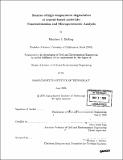| dc.contributor.advisor | Franz-Josef Ulm. | en_US |
| dc.contributor.author | DeJong, Matthew J. (Matthew Justin) | en_US |
| dc.contributor.other | Massachusetts Institute of Technology. Dept. of Civil and Environmental Engineering. | en_US |
| dc.date.accessioned | 2006-02-02T18:53:37Z | |
| dc.date.available | 2006-02-02T18:53:37Z | |
| dc.date.copyright | 2005 | en_US |
| dc.date.issued | 2005 | en_US |
| dc.identifier.uri | http://hdl.handle.net/1721.1/31155 | |
| dc.description | Thesis (S.M.)--Massachusetts Institute of Technology, Dept. of Civil and Environmental Engineering, 2005. | en_US |
| dc.description | Includes bibliographical references (p. 208-213). | en_US |
| dc.description.abstract | The effects of high temperature exposure on cement-based materials have been under investigation for quite some time, but a fundamental understanding of the sources of high temperature degradation has been limited by measurement capabilities. Using recent developments in nanotechnology and microporoelastic modeling, this study identifies sources of high temperature degradation at the nanoscale for the first time. For reference and comparison with existing literature, the traditional methods of thermo-gravimetry, uniaxial compression, and resonant frequency are used to measure mass loss, compressive strength and elastic modulus, respectively. However, microscopic measurement of the elastic modulus and hardness is the primary experimental focus of this study. Microindentation is used to measure the properties of homogenized cement paste, whereas nanoindentation is used to measure the properties of the various phases which make up cement paste. All experimental methods are performed on cement paste subjected to specified investigation temperatures ranging from 250C to 700C. Using experimental results in combination with data in the literature, microporoelastic modeling is used to identify the sources of high temperature elasticity degradation which are inherent to each cement paste phase. Only through this unique combination of experimental and theoretical investigations are two primary sources of high temperature elasticity degradation separately identified at the nanoscale: 1) dehydration (loss of bound water) within the elementary building block of C-S-H, and 2) a decrease in packing density of both the low-density and high-density C-S-H phases above 3000C. Based on these identified sources of high temperature elasticity degradation, a model which predicts the elasticity of cement paste as a function of temperature (up to 700C) is developed. | en_US |
| dc.description.statementofresponsibility | by Matthew J. DeJong. | en_US |
| dc.format.extent | 213 p. | en_US |
| dc.format.extent | 11164139 bytes | |
| dc.format.extent | 11191853 bytes | |
| dc.format.mimetype | application/pdf | |
| dc.format.mimetype | application/pdf | |
| dc.language.iso | eng | en_US |
| dc.publisher | Massachusetts Institute of Technology | en_US |
| dc.rights | M.I.T. theses are protected by copyright. They may be viewed from this source for any purpose, but reproduction or distribution in any format is prohibited without written permission. See provided URL for inquiries about permission. | en_US |
| dc.rights.uri | http://dspace.mit.edu/handle/1721.1/7582 | |
| dc.subject | Civil and Environmental Engineering. | en_US |
| dc.title | Sources of high temperature degradation of cement-based materials : nanoindentation and microporoelastic analysis | en_US |
| dc.type | Thesis | en_US |
| dc.description.degree | S.M. | en_US |
| dc.contributor.department | Massachusetts Institute of Technology. Department of Civil and Environmental Engineering | |
| dc.identifier.oclc | 61206657 | en_US |
